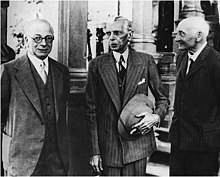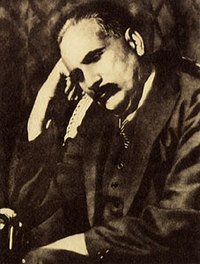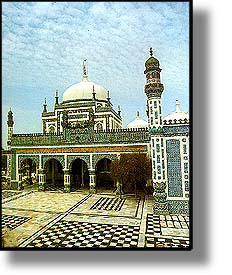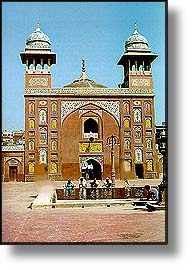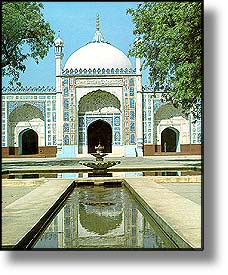Mohammad Ali Jinnah (Urdu: محمد علی جناح, Sindhi: محمد علي جيڻا, Gujarati: મુહમ્મદ અલી જિન્ના,  Audio (help·info)); December 25, 1876 – September 11, 1948) was a 20th century lawyer, politician, statesman and the founder of Pakistan. He is popularly and officially known in Pakistan as Quaid-e-Azam (Urdu: قائد اعظم — "Great Leader") and Baba-e-Qaum (باباۓ قوم) ("Father of the Nation").
Audio (help·info)); December 25, 1876 – September 11, 1948) was a 20th century lawyer, politician, statesman and the founder of Pakistan. He is popularly and officially known in Pakistan as Quaid-e-Azam (Urdu: قائد اعظم — "Great Leader") and Baba-e-Qaum (باباۓ قوم) ("Father of the Nation").
Jinnah served as leader of the All-India Muslim League from 1913 until Pakistan's independence on August 14, 1947 and Pakistan's first Governor-General from August 15, 1947 until his death on September 11, 1948. Jinnah rose to prominence in the Indian National Congress initially expounding ideas of Hindu-Muslim unity and helping shape the 1916 Lucknow Pact between the Muslim League and the Indian National Congress; he also became a key leader in the All India Home Rule League. He proposed a fourteen-point constitutional reform plan to safeguard the political rights of Muslims in a self-governing India.
Jinnah later advocated the Two-Nation Theory embracing the goal of creating a separate Muslim state as per the Lahore Resolution.[7] The League won most reserved Muslim seats in the elections of 1946. After the British and Congress backed out of the Cabinet Mission Plan Jinnah called for a Direct Action Day to achieve the formation of Pakistan. The direct action[8][9] by the Muslim League and its Volunteer Corps, resulted in massive rioting in Calcutta[9][10] between Muslims and Hindus.[10][11] As the Indian National Congress and Muslim League failed to reach a power sharing formula for united India, it prompted both the parties and the British to agree to independence of Pakistan and India. As the first Governor-General of Pakistan, Jinnah led efforts to lay the foundations of the new state of Pakistan, frame national policies and rehabilitate millions of Muslim refugees who had migrated from India.
He died in September 1948, just over a year after Pakistan gained independence from the British Empire.
Early life
Jinnah was the first child born to Mithibai and Jinnahbhai Poonja. His father, Jinnahbhai (1857–1901), was a prosperous Gujarati merchant who had moved to Sindh from Kathiawar, Gujarat before Jinnah's birth.[13][16] His grandfather, Poonja Gokuldas Meghji,[17] was a Hindu Bhatia Rajput from Paneli village in Gondal state in Kathiawar. Jinnah's ancestors were Hindu Rajputs who had converted to Islam.[16] Jinnah's family belonged to the Ismaili Khoja branch of Shi'a Islam,[1] though Jinnah later converted to Twelver Khoja Shia Islam.[2][5][6]
The first-born Jinnah was soon joined by six siblings, brothers Ahmad Ali, Bunde Ali, and Rahmat Ali, and sisters Maryam, Fatima and Shireen. Their mother language was Gujarati; in time they also came to speak Kutchi, Sindhi and English.[18] The proper Muslim names of Mr. Jinnah and his siblings, unlike those of his father and grandfather, are the consequence of the family's immigration to the Muslim state of Sindh.
Jinnah was a restless student, he studied at several schools: at the Sindh-Madrasa-tul-Islam in Karachi; briefly at the Gokal Das Tej Primary School in Bombay; and finally at the Christian Missionary Society High School in Karachi,[12] where, at age sixteen, he passed the matriculation examination of the University of Bombay.[19]
Years in England
In 1892, Jinnah was offered an apprenticeship at the London office of Graham's Shipping and Trading Company, a business that had extensive dealings with Jinnahbhai Poonja's firm in Karachi.[12] Before he left for England, at his mother's urging, he married his distant cousin – Emibai Jinnah, who was two years his junior;[12] she died a few months later. During his sojourn in England, his mother too would pass away.[16] In London, Jinnah soon left the apprenticeship to study law instead, by joining Lincoln's Inn. It is said that the sole reason of Jinnah's joining Lincoln's Inn is that the welcome board of the Lincoln's Inn had the names of the world's all-time top-ten magistrates, and that this list was led by the name of Muhammad. No such board exists, although there is a mural which includes a picture of Muhammad.[16] In three years, at age 19, he became the youngest Indian to be called to the bar in England.[16]During his student years in England, Jinnah came under the spell of 19th-century British liberalism, like many other future Indian independence leaders. This education included exposure to the idea of the democratic nation and progressive politics. He admired William Gladstone and John Morley, British Liberal statesmen. An admirer of the Indian political leaders Dadabhai Naoroji and Sir Pherozeshah Mehta,[20] he worked with other Indian students on the former's successful campaign to become the first Indian to hold a seat in the British Parliament.
By now, Jinnah had developed largely constitutionalist views on Indian self-government, and he condemned both the arrogance of British officials in India and the discrimination practiced by them against Indians. This idea of a nation legitimized by democratic principles and cultural commonalities was antithetical to the genuine diversity that had generally characterized the subcontinent. As an Indian intellectual and political authority, Jinnah would find his commitment to the Western ideal of the nation-state developed during his English education– and the reality of heterogeneous Indian society to be difficult to reconcile during his later political career.
Western influences on personal life
The Western world not only inspired Jinnah in his political life. England had greatly influenced his personal preferences, particularly when it came to dress. Jinnah donned Western style clothing and he pursued the fashion with fervor. It is said he owned over 200 hand-tailored suits which he wore with heavily starched shirts with detachable collars. It is also alleged that he never wore the same silk tie twice.[21]Return to India
During the final period of his stay in England, Jinnah came under considerable pressure to return home when his father's business was ruined. In 1896 he returned to India and settled in Bombay. Jinnah built a house in Malabar Hill, later known as Jinnah House. He became a successful lawyer, gaining particular fame for his skilled handling of the "Caucus Case".[20] His reputation as a skilled lawyer prompted Indian leader Bal Gangadhar Tilak to hire him as defence counsel for his sedition trial in 1908. Jinnah argued that it was not sedition for an Indian to demand freedom and self-government in his own country, but Tilak received a rigorous term of imprisonment.[20]When he returned to India his faith in liberalism and progressive politics was confirmed through his close association with three Indian National Congress stalwarts Gopal Krishna Gokhale, Pherozeshah Mehta and Surendranath Banerjee. These people had an influence in his early life in England and they would influence his later involvement in Indian politics.[22]
Early political career
In 1896, Jinnah joined the Indian National Congress, which was the largest Indian political organization. Like most of the Congress at the time, Jinnah did not favour outright independence, considering British influences on education, law, culture and industry as beneficial to India. Jinnah became a member on the sixty-member Imperial Legislative Council. The council had no real power or authority, and included a large number of un-elected pro-Raj loyalists and Europeans. Nevertheless, Jinnah was instrumental in the passing of the Child Marriages Restraint Act, the legitimization of the Muslim waqf (religious endowments) and was appointed to the Sandhurst committee, which helped establish the Indian Military Academy at Dehra Dun.[13][23] During World War I, Jinnah joined other Indian moderates in supporting the British war effort, hoping that Indians would be rewarded with political freedoms.Jinnah had initially avoided joining the All India Muslim League, founded in 1906, regarding it as too Muslim oriented. However he decided to provide leadership to the Muslim minority. Eventually, he joined the league in 1913 and became the president at the 1916 session in Lucknow. Jinnah was the architect of the 1916 Lucknow Pact between the Congress and the League, bringing them together on most issues regarding self-government and presenting a united front to the British. Jinnah also played an important role in the founding of the All India Home Rule League in 1916. Along with political leaders Annie Besant and Tilak, Jinnah demanded "home rule" for India—the status of a self-governing dominion in the Empire similar to Canada, New Zealand and Australia. He headed the League's Bombay Presidency chapter.
In 1918, Jinnah married his second wife Rattanbai Petit ("Ruttie"), twenty-four years his junior. She was the fashionable young daughter of his personal friend Sir Dinshaw Petit, of an elite Parsi family of Bombay. Unexpectedly there was great opposition to the marriage from Rattanbai's family and Parsi society, as well as orthodox Muslim leaders. Rattanbai defied her family and nominally converted to Islam, adopting (though never using) the name Maryam Jinnah, resulting in a permanent estrangement from her family and Parsi society. The couple resided in Bombay, and frequently travelled across India and Europe. In 1919 she bore Jinnah his only child, daughter Dina Jinnah.
In 1924 Jinnah reorganized the Muslim League, of which he had been president since 1919, and devoted the next seven years attempting to bring about unity among the disparate ranks of Muslims and to develop a rational formula to effect a Hindu Muslim settlement, which he considered the pre condition for Indian freedom. He attended several unity conferences, wrote the Delhi Muslim Proposals in 1927, pleaded for the incorporation of the basic Muslim demands in the Nehru report, and formulated the “Fourteen Points”[24]
Founding of Pakistan
A letter by Jinnah to Winston Churchill
Jinnah gave a precise definition of the term 'Pakistan' in 1941 at Lahore in which he stated:
Some confusion prevails in the minds of some individuals in regard to the use of the word 'Pakistan'. This word has become synonymous with the Lahore resolution owing to the fact that it is a convenient and compendious method of describing [it].... For this reason the British and Indian newspapers generally have adopted the word 'Pakistan' to describe the Moslem demand as embodied in the Lahore resolution.[40]Jinnah issued a call for all Muslims to launch "Direct Action" on August 16 to "achieve Pakistan".[41] Strikes and protests were planned, but violence broke out all over India, especially in Calcutta and the district of Noakhali in Bengal, and more than 7,000 people were killed in Bihar. Although viceroy Lord Wavell asserted that there was "no satisfactory evidence to that effect",[42] League politicians were blamed by the Congress and the media for orchestrating the violence.[43] Interim Government portfolios were announced on October 25, 1946.[44] Muslim Leaguers were sworn in on October 26, 1946.[45] The League entered the interim government, but Jinnah refrained from accepting office for himself. This was credited as a major victory for Jinnah, as the League entered government having rejected both plans, and was allowed to appoint an equal number of ministers despite being the minority party. The coalition was unable to work, resulting in a rising feeling within the Congress that independence of Pakistan was the only way of avoiding political chaos and possible civil war. The Congress agreed to the division of Punjab and Bengal along religious lines in late 1946. The new viceroy Lord Mountbatten of Burma and Indian civil servant V. P. Menon proposed a plan that would create a Muslim dominion in West Punjab, East Bengal, Baluchistan and Sindh. After heated and emotional debate, the Congress approved the plan.[46] The North-West Frontier Province voted to join Pakistan in a referendum in July 1947. Jinnah asserted in a speech in Lahore on October 30, 1947 that the League had accepted independence of Pakistan because "the consequences of any other alternative would have been too disastrous to imagine."[47]
The independent state of Pakistan, created on August 14, 1947, represented the outcome of a campaign on the part of the Indian Muslim community for a Muslim homeland which had been triggered by the British decision to consider transferring power to the people of India.[48]






